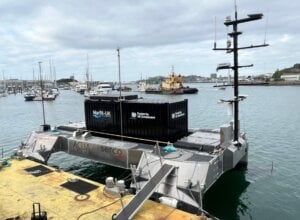
The USV Pioneer completed a cruise out to Plymouth Sound in the UK Southwest on Thursday (16 October), concluding a series of public outreach events throughout the summer.
The 14-metre, 25-tonne aluminium vessel is designed for sensor deployment and recovery, capable of operating at up to 6 knots and enduring heavy seas.
It is equipped with a 63kW lithium-ion battery with a 45kW Nuvera fuel cell range extender. When equipped with its full hydrogen storage capacity of 23kg, the team expects it could operate for up to nine days.

The vessel operated on battery power alone for the 16 October demo due to refuelling restrictions with public viewers. However, it was recharged by GeoPura’s hydrogen power unit while docked.
The team claims it is the first vessel of its kind, equipped with hydrogen, to be awarded the UK Maritime and Coastguard Agency’s Workboat Code certification.
Earlier this year, the vessel completed a 24-hour operation 12 miles off Plymouth’s coast, consuming 9kg of hydrogen in the process.
The company now has its sights set on real-world defence deployments.
“We have been very proud to announce two very important commercial opportunities for us to deliver pilot demonstrations,” said Acua Managing Director Mike Tinmouth.
The European Space Agency has awarded the firm a contract to trial deploy a remotely operated vehicle from the USV for subsurface inspections on data cables and pipelines.
Additionally, the company has secured a UK Ministry of Defence contract to demonstrate the deployment of aerial drones from the vessel at sea.
“Next year, we will be doing both demonstrations,” Tinmouth said. “That gives us a whole range of use cases at sea. Everything from border security and fisheries protection, through to oil and gas, renewables, and subsea cables.”
And while USV Pioneer is zero emission, Tinmouth believes its benefits go beyond climate.
He highlighted easier ballasting versus diesel systems, as well as reduced detectable, thermal and chemical emissions, and lower acoustic interference.
“There are requirements at the moment from a number of programmes that are looking at everything from survey aircraft, through to anti-submarine warfare and carrier escorts,” Tinmouth said.
“There is a big move towards autonomy in the defence and security space. There is an equally large move in the offshore commercial space.”
Construction of a second Pioneer vessel is already planned at an Isle of Wight shipyard, with commissioning targeted for summer 2026.
Never miss a hydrogen headline
Hydrogen moves fast – stay on top of it with our daily and weekly briefings.
- Daily: The top five hydrogen stories, straight to your inbox
- Weekly: The week’s biggest news, features, interviews and analysis
- North American Bulletin: Dedicated coverage of the region’s key hydrogen developments

